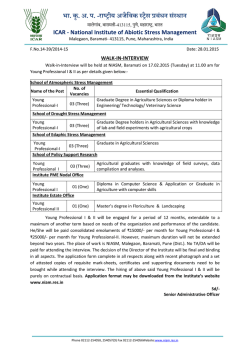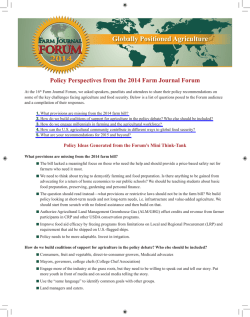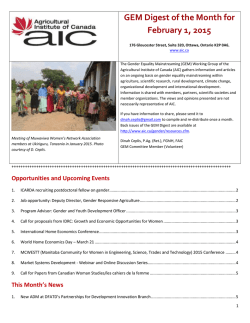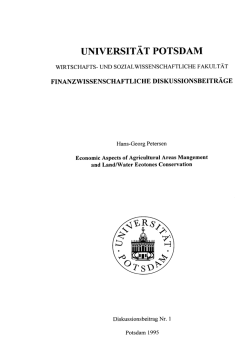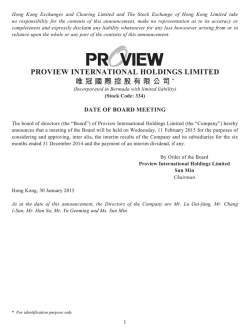
Innovative model of cooperation for small agricultural producers
M PRA Munich Personal RePEc Archive Innovative model of cooperation for small agricultural producers Alexandru Lapusan The Research Institute for Agriculture Economy and Rural Development – ASAS 20. November 2014 Online at http://mpra.ub.uni-muenchen.de/61637/ MPRA Paper No. 61637, posted 28. January 2015 07:52 UTC INNOVATIVE MODEL OF COOPERATION FOR SMALL AGRICULTURAL PRODUCERS ALEXANDRU LĂPUŞAN1 Abstract: The present study has the objective to elaborate an innovative model of cooperation that can represent a general structural solution, beneficial to small agricultural producers, being one of the very few real solutions that can connect them to the agricultural market and to development resources. In the first part of the paper, it is presented a retrospective of the agricultural cooperation route in Romania. The prospects of agricultural cooperation are oriented toward directions and domains of agriculture, for that the innovative cooperation model proposed can represent the functional and advantageous solution for the small agricultural producer. By the interpretation of the RGA data, 2002, 2010, regarding agricultural holdings, corroborated with theoretical and legislative aspects, it was pursued to realize an analysis of the agriculture particularities from our country, highlighting the necesity to develop a cooperation structures (1-st degree cooperative) in agriculture. The perspective analysis of small farmers to join, can be interpreted starting from the questions (Who are the small producers?, Why must find a solution for them? What is their direction of evolution? Why do not associate?) relevant found in SWOT analysis of small individual farms. In the last part of the paper it is defined the legal framework for cooperation of small individual producers, in this context developing the innovative cooperation model, operating principles and conditions for this model to be viable. Keywords: innovative model of cooperation, agricultural cooperation, individual agricultural holdings, small agricultural producer INTRODUCTION The first cooperatives appeared in the middle of XIX-th century in the Great Britain (Pioneers from Rochdale in 1844, in the domain of leather-shoes production) and Germany (cooperation of Raiffeisen type in 1846 and Schulze-Delitzsch type in 1847, in the domain of rural credit). Agricultural cooperatives have developed rapidly, in Germany and the Netherlands, with the expansion of colonial liberation movements, as an effect of defense for small farmers against the policy of redirection of large companies’ capital toward European agriculture. The agricultural cooperatives (particularly those aimed at collecting, storaging and capitalization of cereals, providing complex equipment necessary to the working technologies, processing and capitalization of some products: milk, meat, etc.) were the saving solution that associated have identified and sustained differentiated, accepting the principle of equal vote. In other words, only when the threat of existence was perceptible, it was agreed the association, in which that with greater potential, voluntarily contributed more to the establishment of cooperative, accepting the compromise of equal vote (one man one vote). Under these conditions, between associated could exist only persons that had the same purpose and therefore the same interests. The first definition of cooperation is attributed to Robert Owen (1771-1858), but the definition of cooperation as a general or specific organization (for various objects of activity), is reflected in the concerns of a long series of researchers, in various compendiums, dictionaries and clear in legislation. The definition of cooperation given by Centenary Congress of the International Cooperative Alliance (ICA) in 1966 is much broader, general, allowing the inclusion in the international structures of the diversity of cooperative legal entities: Cooperative is an autonomous association of persons united voluntarily to meet the economic, social and cultural needs and aspirations, through a institution jointly owned and controlled systematically. Cooperation in Romania, in the prewar period In Romania, among the promoters of cooperation, were Ion Ionescu de la Brad (18181891) and Spiru Haret (1851-1912), the latter being considered the founder of the popular 1 PhD Eng., Director of Research Institute for Agriculture Economy and Rural Development – ASAS, Bucharest, 61 Mărăşti Blvd., e-mail: [email protected] cooperative banks and the initiator of the first law of cooperation. In the interwar period, political personalities with concerns in the cooperation domain are: I.G. Duca, Ion Mihalache, Virgil N. Madgearu, Gromoslav Mladenatz etc. I.G. Duca, Minister of Agriculture and Domains underlined in the letter for King Ferdinand, after the approval of Decree-Law 3922 / 31.12.1918, relative to the establishing of central body of cooperation ... "Sire, ... Indeed, the cooperation started at us in so unfavorable conditions and had to overcome so great difficulties that the State had to take under its direct care of the whole movement. Without close mixture, without wide help, without thorough control of the State, nor popular Banks, or village Cooperatives of all kinds, no leasing or purchasing Communities could have... to bring to rural population the benefits brought them, the most thorough, maybe, from all the gains that our peasantry whom from the establishing of the modern Romanian State. It is true, however, that this tutelage of the State is not an ideal ... and that trend should be like the movement to be led by its own means and its own power. " Table no.1: Agricultural cooperatives of production and consumption - 1937 No. coop. No. members Capital thousand lei Moldova 83 5.562 4.389 Muntenia 155 12.337 5.185 Dobrogea 60 4.739 3.877 Oltenia 29 2.597 2.085 Basarabia 65 5.071 3.284 Bucovina 40 2.695 1.449 Transilvania 77 4.792 4.964 Total 509 37.793 25.233 Source: L’agriculture en Roumanie, Atlas Statistique, Bucharest 1938 Province The Great Unification of 1918 meant the reunification in a unitary coordination of the cooperative movement in all provinces. Due to the concerns of the state: adoption of a favorable legislation, establishment of specific coordination institutions, insuring mechanisms and resources to finance agriculture, the cooperation has a significant development. Compared to 1918, following the inventory made in 1931, the number of cooperatives will double. On 1 January 1931 the number of cooperatives was 7,436, of which 6.879 in the rural area (A.G. Galan). Of those working in rural areas, 4824 representing 70.12% of total were credit cooperatives (popular banks) and only 2,055 were agricultural cooperatives for services or forestry. O relatively similar situation is maintained also at the end of 1937, when recorded 7741 stock cooperatives, of which 5,183 were credit unions (66%). Table no.2: Agricultural associations for renting land - 1937 No. associations No. members Capital thousand lei Moldova 37 4.125 5.652 Muntenia 149 12920 5.993 Dobrogea x x x Oltenia 35 3.064 1.975 Basarabia 2 246 37 Bucovina 1 65 500 Transilvania 7 408 557 Total 231 20.828 14.714 Source: L’agriculture en Roumanie, Atlas Statistique, Bucharest 1938 Province Surfaces rented 8.792 24.993 x 3.221 562 87 3.846 41.501 The other cooperatives in number of 2,087 (34%) covers the following areas: consumer cooperatives (13%), supply and delivery (4.6%), communities for purchase and lease (2.46%), forestry (3.24%), other profiles (10.7%). Due to disfunctionalities in the system (generated by the system rigidity, but mostly because of political struggle and corruption), in 1932, a law for the conversion of agricultural debts was adopted and in 1934 the law on agricultural and urban debts conversion, leading to stopping the financing of small producer. The National Bank tried to compensate the lack of liquidity (providing funds for farmers, through the Popular Bank and private banks). The approval of the Law on the cooperation reform (23 July 1938) and the coverage by the state of losses (2.5 billions lei) after conversion law enforcement, on external tensions finalized with the beginning of the World War II, meant the decline of Romanian agricultural cooperation. Unlike European experiences, where, after establishing of the new cooperative structures, the authorities encouraged freedom of initiative, in Romania, the state was a disturbing and inhibiting of their evolution. Political struggle and corruption occurred also in the cooperation, causing large imbalances both in terms of organization and finance. The Minister of agriculture and domains, Vasile P. Sassu, ordered during 1938-1939 an analysis of Romanian cooperative system, conducted by the Danish expert M.Gormsen. Some of the conclusions of analysis at the time, are viable solutions for the current situation of agriculture: limitation by law of divisibility of agricultural properties, merging properties, cadastre generalization, generalization of crop rotation, local roads, plants and animals of superior varieties and breeds, agricultural education, elimination of landowners interests, correct and disinterested operation of courts and central and local administrations etc. One of the great Romanian specialists of the time, Marin Chiriţescu - Arva (1889-1935), considered that "organizing the agricultural peasant production based on cooperatives, with preserving the private property" could be the solution that would give perennity to agricultural cooperation. An element to note, less important at all, is that the organization and development of structures with beneficial effects for agriculture, particularly those aimed at agricultural cooperation, were promoted by outstanding personalities of the time, have been implemented and have developed with support from the state and have fallen due to ignorance of the realistic solutions of moment, the exacerbation of the political struggle and corruption. The necessity of occurrence of cooperation People acted jointly since ancient times to achieve objectives such as: food security, defense, expansion, etc. As the joint actions passed from the state of native motivation in the conscious, the society outlined two broad categories of activities: state administrative (state power) and economic / lucrative / commercial (which produced goods and services for all society). Persons (individual and legal) are associated for the common development of patrimony / lucrative activities (in order to obtain profit) or non-patrimony / non-lucrative (non-profit). For the lucrative activities, the consecrated form of association is represented by the commercial society, in its various forms of organization, defined by Law 31/1990 (R): joint stock company (SA) with limited liability (SRL), etc. The goal of commercial societies is to obtain profit, in order to develop the company and / or distribution as dividends to shareholders. The right of expression for associates and the right for benefits in the company are established by statute, but in all cases these rights are proportional with the contribution to the capital. Upon liquidation of companies, after the payment of all obligations, the assets remaining (if there exists) is divided (in value) according to the percentage contribution of each partner to share capital. In contrast to the commercial societies, are the non -patrimonial / non-lucrative / non-profit associations and foundations, defined by Government Ordinance 26/2000, amended by a series of subsequent laws. These legal entities (minimum three persons for associations and one or more persons for foundations) aimed at developing activities for public interest or for community, and (only for associations) activities in their own interest (nonpatrimonial purpose). The initial patrimony (which has a level determined by the law) is established by the associates’ contribution and is not eligible for refund in case of liquidation of the sssociation / foundation. With the evolution of society and the modernization of lucrative structures, the state was put in a position to adapt the mechanisms for surveillance, knowledge and taxing each economic sector’s income. The dilemma between the necessity to tax any income and to support activities which took over a part of public needs and could reduce certain costs incumbent the state, led to the adoption of differentiated tax systems. The economic and social structures have known a great development while the evolution of democracy. The cooperatives have emerged as a social economic necessity, addressing the needs of the large class of small producers. Taking specific elements from the objectives and the purpose of companies and non-profit entities, the cooperatives were able to shape a distinctive purpose that has proven its viability and offer future development prospects. Agricultural cooperatives in Romania, in 2010 From the analysis of existing public data, in 2010 results that fewer cooperatives have over 10 members, and at the country level, the total number of producers associated in agricultural cooperatives is around 1,000 people. Most of the existing cooperatives are not established on cooperation principles, do not have the motivation of operation in this structure and therefore the organizational and economic performances are not encouraging. No. 0 1 2 3 4 5 6 7 8 9 10 11 12 Table no. 3: Agricultural cooperatives from Romania No. agr. County /(No. of counties) coop. / county 1 2 CJ, NT, TL, HD, VS (Nr.=5) 0 GL, BT, GJ, CS, BN, GR (Nr.=6) 1 IS, PH, AR, SB, MS, MM, VL, MH, AB, CV (Nr.= 10) 2 BC, SJ, HR, IF, TM (Nr.= 5) 3 BV, AG, BZ, SM (Nr.= 4) 4 DJ, BR, BH (Nr.=3) 5 SV, DB, IL (Nr.= 3) 6 CL, TL (Nr.= 2) 7 OT (Nr.= 1) 10 VN (Nr.= 1) 16 CT (Nr.= 1) 19 TOTAL x Source: Data processing after MADR-ANCA – Agricultural cooperatives 2010 Total agr. coop. (No.col.1x col 2.) 3 0 6 20 15 16 15 18 14 10 16 19 149 The number and structure of agricultural cooperatives by counties reflect the slow process of their formation (Table 3), the last two years not registering any new cooperative. The structure of the cooperation on production activities reflects a very different coverage (Table 4). The entities from agriculture, including agricultural cooperation, are represented at European level through institutions partners to the executive authorities. Immediately after the signing of the Treaty of Rome for establishing the European Economic Community (EEC, 25 March 1957) which already contained a number of provisions of the future Common Agricultural Policy (CAP), was established on September 6, 1958 the Committee of Professional Organisations from Agricultural (COPA) and in September 29, 1959 the General Confederation of Agricultural Cooperatives (COGECA), institutions representing companies (farms), agricultural cooperatives respectivelly, in relation with the European authorities. From September 1, 1962, the secretariats of the two representative institutions join and establish COPA-COGECA. The National Federation of Romanian Farmers (FNPAR) is a member of the European COPA-COGECA. No. 1 2 3 4 5 6 7 8 Table no. 4: The structure of agricultural cooperatives by production activity Main object of activity No. No. Main object of activity coop. Production of vegetables (including 9 Cultivating potatoes 23 greenhouses) Vegetal production (cereals) 10 Raising pigs 18 Beekeeping 11 Raising poultry 18 Raising sheep (processing sheep milk) 12 Slaughtering/ processing meat 13 Raising cattle (producing/ processing 12 Raising snails 10 milk) Other agr. coop. for mixt production: Horticulture 14 10 vegetal-animal), processing, comerce etc. Producing wine 15 Services for agriculture 7 Fishing TOTAL agricultural cooperatives 31.12.2009 5 Source: Data processing after MADR-ANCA – Agricultural cooperatives 2010 No. coop. 3 2 1 3 1 30 5 149 In Romania, there have not been created up to present cooperation structures, similar to those from the old Member States of the European Union. It is obviously that no specific structures of representation there are. The lack of a clear attitude of the political class to reflect in the government engagement programs and the lack of adequate legislation to stimulate the establishing and development of cooperatives could mean, for 65% of Romania's agriculture not only further reduce of the chances of benefiting from European funds, but most likely, the degradation of the situation pursuant to the new CAP regulations since 2014. Legal organization of agricultural holdings in Romania The agricultural holdings from Romania are organized in farms with legal personality and without personality which are divided into authorized physical persons (OUG no. 44/2008) and individual agricultural holdings. To use this analysis we refer to individual agricultural holdings. The changes in the structure of agricultural holdings in the period 2002 – 2010 result from the data contained in the tables below. Table no. 5: The number and size of agricultural holdings in Romania UM 2002 2010 Total agricultural holdings without legal personality, of which: Individual agricultural holdings Individual agricultural holdings Total agricultural surface of holdings Individual agricultural holdings Individual agricultural holdings Agricultural surface used of agricultural holdings Individual agricultural holdings Individual agricultural holdings Average agricultural surface used of agricultural holdings Individual agricultural holdings Cooperative units Source: General AgriculturalCensus, 2002, 2010 thousands % th. ha % th. ha % ha no. 4.299 4277.3 99.5 15.708 8.454 53.8 3721.8 3686,7 99.1 15.867 8194 51.6 2010/2002 +/-577.2 -590.6 x +159.0 -260.0 x 13.931 13.298 -633.0 7708.8 55.3 3,11 1,80 87 7154.2 53.8 3,45 1,94 67 -554.6 x +0.3 +0.16 -20 The number of individual farms has decreased in the period 2002-2010, with - 590 000 (13.8%), calculated as a dynamic of the number of agricultural holdings in 2010 compared to 2002. The share of individual agricultural holdings in total number of agricultural holdings is almost constant, ranging from 99.5% in 2002 to 99.1% (-0.4%) in 2010. The total area used by farms is reduced by -633 000 ha (4.5%) between 2002-2010, which means an average size of 3.11- 3.45 ha / farm (+0.3 ha). The share of individual holdings in total agricultural area (UAA) is reduced by 1.5% between 2002-2010. The number of people who worked in agriculture decreased from 9,007,000 in 2002 to 7,159,000 in 2010. There are a total of 67 agricultural cooperatives using an average agricultural surface of 122.03 ha / farm. Although the number of agricultural associations in 2010 was 127 units, not all have farms, but have other types of services for members. From the analysis of the General Agricultural Census data, in terms of the number of agricultural individual holdings, by size classes, it appears that in the period 2002-2010, the small farms in class 0.1 to 1 ha, have the highest share of over 50% (in 2010), using 5.5% of the agricultural area, which is a clear indication of the persistence of phenomenon of subsistence farming. From the individual analysis, by size classes, it can be observed the downward trend in individual holdings (for range below 1 ha - 5 ha) in favor of larger sizes. The size class between 1050 hectares has the highest share of ranking (+ 3.9%), followed by the class over 100 ha (+ 2.3%) and the class 50-100 ha (+1.5%). (Table 6) The size class size between 10-50 hectares has the highest share of ranking (+ 3.9%), followed by class over 100 ha (+ 2.3%) and class 50-100 ha (+1.5%). (Table 6) Table no. 6: Situation of individual agricultural holdings in Romania 2002 Size class (ha) under 0.1 -1 1-5 5 - 10 10 - 50 50 - 100 over 100 Total Average size (ha) Number of individual agricultural holdings (th.) 2166.0 1846.1 215.7 44.5 2.8 2.2 4277.3 % of the total number 50.4 42.9 5.0 1.0 0.1 0.1 99.5 1.80 2010 % of UAA 5.4 29.9 10.2 5.1 1.3 3.4 55.3 Number of individual agricultural holdings (th.) 1871.0 1518.3 219.0 69.5 5.4 3.6 3686.7 % of the total number % of UAA 50.3 40.8 5.9 1.9 0.1 0.1 99.1 1.94 5.5 26.3 11.0 9.0 2.8 5.7 53.8 Source: RGA 2002, 2010 Who are the small producers? Because there is no definition of the small farms, for the use of this analysis we will consider the holdings under 5 ha. The 3.3 million holdings, under 5 hectares, mean 91% of the farms, working 47.4% of the national agricultural surface. These small farms have a dual role for the rural world, because it provides food and social security, contribute to environmental preservation through the use of traditional production methods and to ensure a certain social protection for rural residents who worked in the former agricultural cooperatives of production and whose pensions are insufficient for a decent living. Overall in 2010, individual farms were exploiting 53.8% of UAA, the remaining of 47.2% being of the holdings with legal personality. In the livestock sector, over 90% of animals are in the individual agricultural holdings, except porcine species (65.5%) and poultry (61.4%). RGA data presented in 2010 confirm the family character of the majority of agricultural holdings. Why we need to find a solution for the small producers? The small producers, both in the plant sector and in animal husbandry have a considerable share in the total number of farms (over 90%), both as land area and as livestock. The average size of individual farms (country level) increased by 0.14% in 8 years. The negative consequences are related to excessive parceling of the land, which leads to hard administration of the production quotas, subsidies, and in general of any agricultural policy measures. Which is their evolution direction? The general trend of evolution can hide a wide variety of situations depending on geographic location and technical and economic orientation of the holdings. We appreciate that the evolution direction of small individual farms can turn to (Fig. No.1): Fig. no. 1 Possible (theoretically) evolutions Increasing the share of aged population Sale land (to Romanian and foreign people) The evolution direction of the small individual agricultural farms (peasant husbandries) Consolidation of agricultural exploitations in the existing form Expanding large farms (see poor areas) Merging of agricultural land Association of individual farmers Association in 1-st degree cooperatives Table no.7: The SWOT analysis of small individual farms (peasant husbandries) STRENGTHS significant agricultural area with a high percentage of utilized agricultural area high percentages of those working in agriculture; tradition in the domain of raising animals allocation of significant financial packages for farm development Romanian market for agricultural products has a high growth potential. the offer for healthy products is of great variety high potential for adaptation and response to public support perceptible. WEAKNESSES large number of small farms (subsistence and semi-subsistence) using a large share of UAA and a large part of the workforce. have not been defined the types of farms, peasant husbandries, which are intended to be supported differentially by public policies reticences to association for capitalizing the production obtained from agriculture. legislation for agricultural cooperation, confused and disincentive. inefficient operation of the market for agricultural products in some sectors. Lack of local market structures. weak development of nonagricultural activities generates dependence of rural population on subsistence agriculture. low level of household income. There are no programs for: integration of agricultural production with processing, industrialization and marketing of agricultural products. development of local cooperative network. principles which state support to agricultural producers should be based on low access to financial resources; insufficient infrastructure (material and informational). after 1989 did not exist programs to develop cooperative networks OPPORTUNITIES can have access to markets (establishment of forms of cooperation). access to PNDR 20142020 program easier access to information about domestic and foreign markets. important financial allocation for Romania in the CAP. development possibilities of processing and distribution activities in rural areas creation and development of local supply chains for food products and sales networks that connect producers and consumers, including ensuring a better link between rural and urban areas. increasing the quantity and quality of agricultural products. possibility of using the risk management tools in agriculture (crop, animals and plants insurance, the establishment of mutual funds, income stabilization). increasing the production yields of farms and producers' incomes through the rational use of resources. economic and organizational consolidation of farms; development of cooperative local networks. RISKS maintain a high degree of fragmentation of farms, with implications at farm level performance and viability. can become victims of large landowners abandonment of activity due to increased costs for agriculture inputs (fuel, chemical products for fertilizing and treatment) and for cost of bank loans. mistrust of small producers in associative forms; there is no adequate and stimulative legislation emphasizing the nonusing degree of labor force from rural areas. maintaining a part of the not taxed economy maintain the current state of demographic and managerial aging of farmers. menţinerea gradului redus de inserţie în fluxurile de piaţă a gospodăriilor ţărăneşti. maintaining the low level of insertion peasant husbandries in the market flows Trying an assessment of the opportunities presented in the SWOT analysis, we can say that: - the association in producers groups is a solution for specialized producers (vegetables, fruits, etc.); - the association in 1-st degree cooperatives is a solution for the individual farmer. Why the individual small farmers do not associate? In our opinion, the small agricultural producers are reluctant to association, due to: - confusion (maintained) between former CAP and agricultural cooperation; - 24% VAT and 16% tax on profit; - absence of programs to stimulate the establishment and maintenance of agricultural cooperatives, etc. Cooperation The legal framework of cooperation of individual small producer is the Law 566/2004. According to this law, the cooperatives are associations of physic persons (cooperatives of I-st degree) or legal persons (cooperatives of II-nd degree: associations of cooperatives of I-st degree), that owning properties and total independence of their production activity, are associated in a new legal entity, to solve common needs (supply, storage, marketing, processing, social, etc.). The members of the cooperative set at establish a patrimony, each of them owning shares in proportion with the contribution brought. In the decisional process, however, each member has one vote. When loss the membership, the former cooperator or its successors receive a part of the share (divisible) of the value of shares had / inherited, the other part (indivisible) remaining for the cooperative development. The cooperatives had and have the support of public authorities due to at least the following reasons: - using of local resources in their activities (raw materials, labor force, public utilities, etc.); - ensure a big volume of products, covering a diverse range of markets; - are tax paying (for patrimony and commercial activities); - develop a mutual activity and for the support of local communities that co-operators are bound organic and functional; - their disappearance could create (at least locally) economic and social imbalances; - are interest groups with voting right. Even if there was a differentiated approach of the states for cooperation, it can say that outside of the discriminatory treatment in the application of general economic policies, the cooperation has benefited (and benefits) of fiscal advantages, motivated by the mutual activity. Once become a legal entity, the cooperative, or any association of it with third physic or legal persons, must comply with the law, without any discrimination or advantage that would vitiate the economic environment in relation with other market players. The purpose of cooperatives is not primarily the profit obtaining, but satisfying the needs of members. Like any economic entity, to achieve its mission, the cooperative must register a positive economic balance (revenueexpenditures) and therefore a profit, which does not have as unique and priority destination the distribution of dividends. The cooperators put for their base of association the status of owners for production units (handicraft workshop, agricultural farm, peasant husbandry, equipment etc., which generally provide the resources of their family) and associates under the seven cooperative principles, in a new legal entity called cooperative, to put in value the own production units by: supply (rhythmic, raw materials and good quality products, at low price), storaging production (grain silos, warehouses for fruits and vegetables, cold storages etc.), marketing of production (fresh vegetables and fruits, etc.), processing (mills, slaughterhouses, dairies, canned products, beverages, etc.), funding and activities (social or mutual) aimed at the community and individual needs. This may be one of the definitions of agricultural cooperatives of I-st degree (association of physic persons) in its native state, as it emerged and developed (over 150 years) throughout the West. It results that these legal entities are associations constituted of owners of production units (quality that and keep fully and after association), which in this quality associate with other partners to solve common problems. Not any person can associate to form a cooperative. These people should have the same quality in association, the same interests and to agree the seven cooperative principles which are the base of establishing the cooperative. Innovative model of cooperation The innovative model of cooperation for small agricultural producers (Figure no. 2) we propose shows the necessity to develop forms of cooperation in order to capitalization production in terms of opening market opportunities for the small producer, by promoting and selling products, individually, or jointly. Direct sale by the small producer is part of this aspect, and this can be done directly from the farm or through markets. The circuits of selling agricultural products directly or through cooperative can take place in a variety of ways. Thus there may be: Variant of producer - local market, which is the shortest distribution channel. In such a circuit, can be found different products, such as vegetables, eggs, meat etc. and bio-organic food. Variant of producer - cooperative - organized market. In this case, the cooperative takes goods from producers, through the warehouses, distribution or procurement and reception organized centers, which later, based on arrangements between cooperative and buyer (partnership), it sells. This is the case ofl fruits and vegetables produced in high season and for fresh consumption. Support is needed to facilitate the access for small producers on market and to enter and operate in these markets at the required standards, including in food safety issues. Thus, by integrated investment in modernization of production, collection, storage and processing would give small producers the opportunity to sale products on local markets, to expand the range of products and promote the marketing of local products. Fig. no 2: Innovative model of cooperation Principles / conditions of the innovative model of cooperation Principles - Apply the seven principles of cooperation defined by the Law 566/2004; - The household as a whole, to be considered as the production unit of the cooperator; - The relation cooperator - cooperative will be considered as being inside the cooperative (without taxes for movement of goods, contributions, etc.); - - The cooperator will be taxed based on statements (ANAF 221 and 260) giving the possibility of deducting all costs related to agricultural activity (including for own consumption; Application of PNDR projects similar to POSDRU Axis 6 (centres of sociale economy approx. 200 thousand euro / center) for sustaining the establishment of cooperatives; The small individual producer, unauthorized individual person will be considered vulnerable for the purposes of prioritizing political programs in this direction. Conditions: - Amend legislation; - Adaptation of European programs to support agricultural cooperatives; BIBLIOGRAPHY 1. Băcescu Marius: Cooperaţia rurală - o şansă pentru revigorareasatului românesc - Revista Română de Statistică nr .6/2010 2. Bică Valer-Vasile: Contractul de arendare - Editura Cermaprint,2005 ISBN 973-87013-2-5 3. Bohareţ Valentin, Dobay Krisztina: Asociaţii de marketing înagricultură, Editura Terra Nostra, Iaşi 2001 ISBN 973-99399-6-1 4. Bold Ioan, Crăciun Avram: Structuri agricole în lume -Editura MIRTON, Timişoara,1996 5. Cruceru Dan: Cooperaţia în România - Editura Artifex, Bucureşti, 1998, ISBN 973-97735-1-6 6. Cruceru Dan: Istoria şi doctrina cooperatistă – Editura Artifex, Bucureşti, 1996 7. Dângă Dumitru: Managementul societăţilor cooperative - Editura Artifex, Bucureşti, 2000 8. Gromoslav Mladenatz: Tratat general de cooperaţie – Bucureşti, 1934 9. G. Ionescu - ªiseşti: Reforma agrară şi producţiunea- cu un program pentru ridicarea agriculturei - Institutul Economic Românesc, Editura Cartea Românească SA, Bucureşti, 1925 10. Lăpuşan Alexandru: Structuri agrare - Banea Press Bucureşti 2002ISBN 973-8115-18-3 18. Neagu Victor, Gheorghe Stanciu: România - Carta europeană a spaţiului rural - Editura Ceres, 1996ISBN 97340-0374-7 11. Otiman Păun: Agricultura României la cumpăna dintre mileniile II şi III - Editura Helicon, Timişoara,1994 12. Popovici Dan Cristian: Experienţa istorică a României în organizarea, funcţionarea şi dezvoltarea cooperaţiei agricole-perspective - Parlamentul României- Camera Deputaţilor, Monitorul Oficial Bucureşti, 1995 13. * * * Why do we need a Common Agriculture Policy - European Commission, DG - Agriculture and Rural Development, December, 2009 14. * * * Scenar 2020-II, Update of scenario study on agriculture and the rural world- final report - European Commission,DG - Agriculture and Rural Development, December, 2009 14. * * * Cooperative 2010 - MADR, ANCA ( pagina web ofi- cială), septembrie 2010 16. * * * Politica Agricolă Comună după 2013-posibilă configuraţie din perspectiva României - MADR, Bucureşti, 21 aprilie 2010 17. * * * Legea 31/1990 (R) privind societăţile comerciale - M.O.nr.126-127/1990M.O. nr.1066/2004 18. * * * Legea 36/1991 privind societăţile agricole şi alte forme de asociere în agricultură - M.O.nr.97/ 1991 19. * * * Legea 16/1994- Legea arendării (modificată prin: Legea 223/2006 şi Legea 20/2008) - M.O.nr.91/1994; (M.O. nr. 497/ 2006 şi M.O.nr.170/2008) 20. * * * Legea 566/2004-Legea cooperaţiei agricole - M.O.nr.1236/2004 21. * * * Legea 1/2005- Legea privind organizarea şI funcţionarea cooperaţiei - M.O.nr.172/2005 22. * * * OU 99/ 2006 privind instituţiile de credit şi adecvarea capitalului - M.O.nr.27/2006
© Copyright 2025
